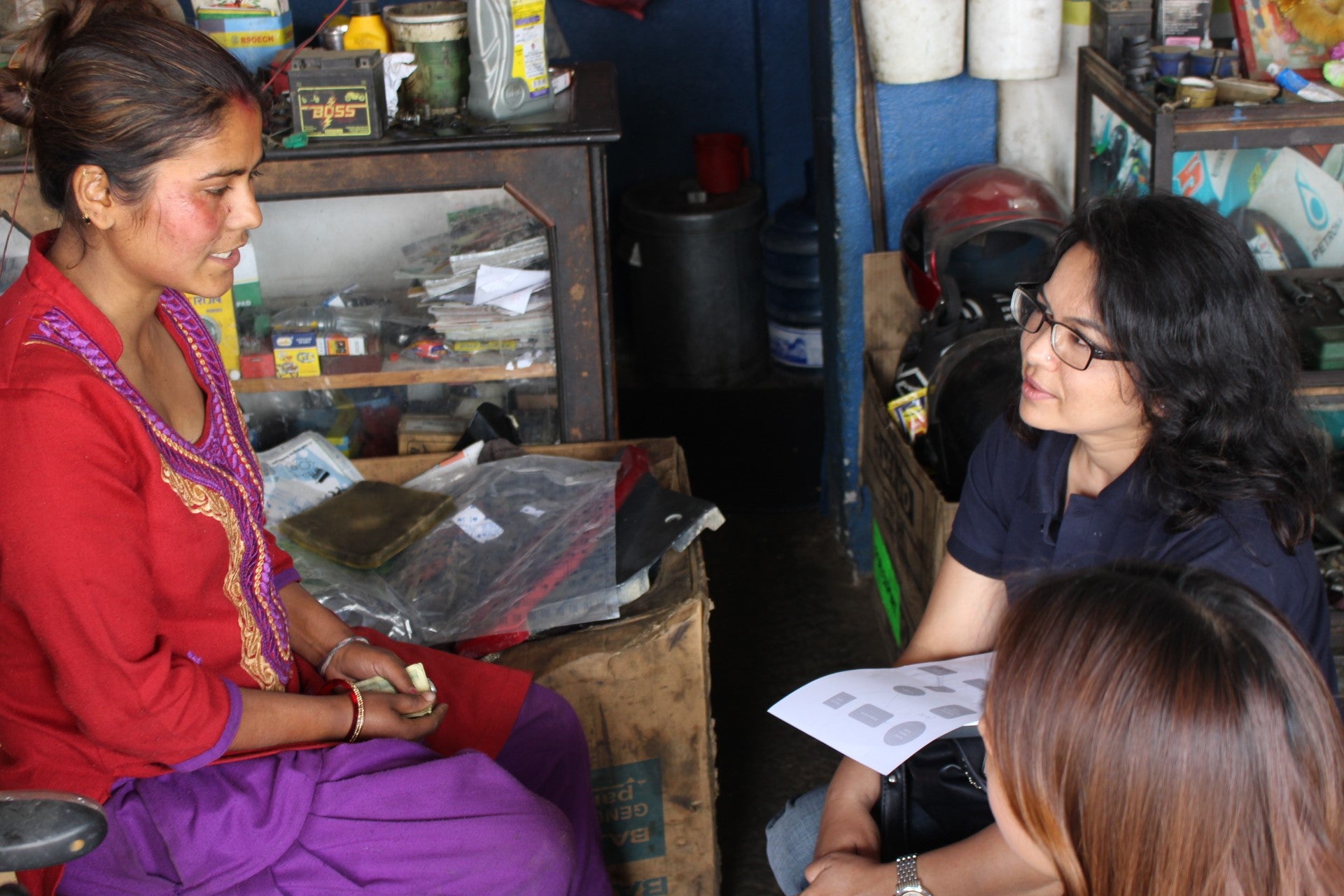Turning Remittances into Savings for Nepal’s Migrant Families
“I’m in a perpetual time crunch. I manage my motorcycle repair business in the absence of my husband, a migrant worker in Saudi Arabia, while I attend to my infant children,” says Binita, a 23-year-old woman, entrepreneur and remittance recipient in Banepa, Nepal.
Saving is also a challenge for Binita, but not because she doesn’t earn enough money. She says she can save up to NPR 3000 (about $30) a month from her business. And her husband, who migrated for work to Saudi Arabia, sends a remittance to Binita each month. The problem is that she doesn’t have convenient access to financial services that she trusts.
“Every month, I visit a remittance agent to send money to my sister studying in India, but I don’t have time to visit a bank to deposit my daily savings. Lines in banks are long and I don’t have 30-45 minutes to spare. If someone can come to my home or shop to collect this money, I’d be happy to save, but I am not going anywhere,” she says.
Since Binita doesn’t save her earnings in a bank and does not feel comfortable using a mobile phone for financial transactions, she ends up spending the money she puts aside every month.

Binita’s experience is common among remittance recipients in Nepal. An estimated 1,750 people migrate internationally from Nepal every day, most of them young men who, like Binita’s husband, are driven by economic reasons to find work in other countries. Many send remittances back home to their families. The World Bank estimates that Nepal received $8.1 billion in remittance inflows in 2018, representing 28 percent of its GDP.
But low savings is typical among young migrants and their families back in Nepal. Young women, who are commonly the ones to remain in the country, earn less and face significant expenses related to family responsibilities, so their savings and investments are limited. The 2017 Global Findex for Nepal found that just 35 percent of youth saved anything at all in 2016, compared to 51 percent of adults. Even in the use of informal savings and borrowing, older adults surpassed youth by 12 percentage points. When UNCDF talked to 181 families in the migration-heavy, semi-urban municipalities of Banepa, Panchkal and Jankapur, it consistently found a lack of savings, investment and formal borrowing among remittance-receiving households, many of which are headed by young women.
Digital financial services could improve migrant families’ saving rates, but this means designing services that better meet their needs, with an emphasis on the needs of the young women who typically remain in the country. Youth are leading Nepal’s mobile and digital revolution. Half the active users of eSewa, Nepal’s most prevalent mobile wallet, are 18 to 30 years old. However, even though women make up 60 percent of eSewa’s 40,000 agents, less than 15 percent of the wallet’s active users are women. Women who use the service under the aegis of a male family member are invisible in the data, but nevertheless there remains a large gender gap that needs to be addressed.
To improve financial inclusion among migrants and their families, UNCDF in Nepal with the technical assistance of Amarante Consulting, is exploring a partnership with Laxmi Bank to drive remittance-linked use cases for migrant workers and their families. This initiative includes the design and delivery of credit and deposit products tailored to migrant families’ needs, with close attention to the gendered dimension of migration and remittances.
UNCDF’s experience in Nepal to date demonstrates that digital interactions with customers alone are not enough to encourage the use of digital financial services, especially when it comes to female customers. Nepal is a cash-based economy that thrives on communal networks, with women heavily relying on informal sources of finance such as savings groups and cooperatives. Product design and delivery are important to consider when encouraging the use of digitally enabled formal financial services, but this transition is not an overnight journey and may require providers to invest in face-to-face engagement with customers, a point CGAP has emphasized in its ongoing research with fintechs around the world.
An example of thoughtful cash-to-digital design that balances digital solutions with in-person interaction is Laxmi Bank’s use of tablet banking to enable doorstep collection services. Launched in March 2019 in Banepa, female staff from Laxmi Bank visit customers in their homes and shops to collect daily earnings using tablets. Customers, mostly women, simply hand their cash to the staff member and enter their account number and the amount on the tablet.
Binita and her neighbors have started using this service. For women like Binita, who are not comfortable yet using a mobile phone for their financing needs, this has been a helpful experience. The coupling of human interaction with digital banking does something important: it makes the transition from cash to digital easier and could possibly enable the use of more sophisticated digital financial services, such as mobile banking and wallets.
Nepal’s youth-led digital ecosystem reveals potential to leverage digital financial services in the remittances space to unlock access to finance and opportunities for youth and their families. Yet, as Nepal demonstrates, the socioeconomic realities of youth migrants and their families will shape how digital financial services are used and to what degree. Financial services must be designed with the needs of young women in mind, and this includes balancing digital solutions with in-person engagement.
This post is part of CGAP's "Financial Services in Youth Education and Employment" blog series.The series explores the challenge of youth financial inclusion from a variety of angles, including the ways young people are using digital financial services, strategies that financial services providers are using to reach more young customers, and the changing role of funders in this space.




Add new comment